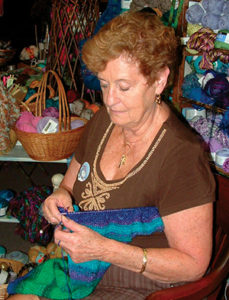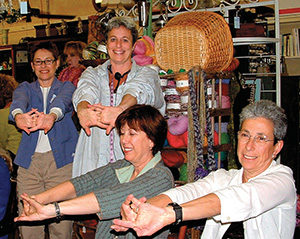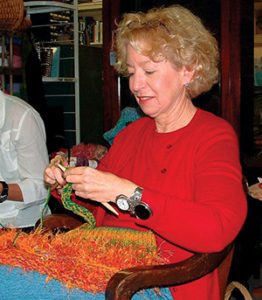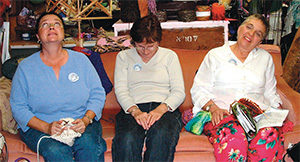KNITTING’S NOT SUPPOSED TO HURT — BUT SOMETIMES IT DOES. SOMETIMES KNITTING PAIN IS YOUR FAULT, SOMETIMES NATURE’S.
What I’m about to discuss is no substitute for medical advice. It’s just a longtime knitter’s observations and experience. Take it as you would if you were having a conversation with a friend about knitting pain. If these solutions don’t work for you, please consult your physician.
Knitting Pain from Repetitive Motion Problems
Power Knitters are most likely to be prone to chronic wrist and hand pain caused by the relentless knit and purl motions of the same muscle groups. Eventually, the nerves in the wrist can be so compromised that carpal tunnel syndrome develops.
Think of knitting as a rigorous workout performed day in and day out. Those muscles need a break. As much as I hate to say it, there’s nothing like a holiday from knitting to begin your therapy. Give your hands a rest from knitting, and substitute another creative activity that uses fine motor skills but other muscles in the affected areas. Try beading or stringing jewelry, painting or drawing, computer games, pulling weeds or working out. Continuing with these activities once you’re back to your knitting needles will help to balance your hands’ workouts and reduce knitting pain.
Switch Knitting
When the repetitive motion knitting pain becomes chronic, you may have to change your knitting technique or alternate several styles from one project to another. Throwers can learn to use their hands less by adapting to the more passive way of teasing the yarn around the needle with your right index finger. Of course, that finger will also get worn out, which is why you’ll continue to take breaks, exercise and alternate techniques. Try bracing a left straight knitting needle on your hip or under your left arm. (Photo 1)
Pickers, experiment with purling opposite to the way you’re used to. This automatically makes a change in the way you knit.
Lots of knitters find continental knitting more comfortable than purling. Try a transAtlantic approach by picking on your knit rows and throwing on your purl rows.
These ideas are based on trying to give all your knitting muscles a chance to get in on the action. You can accomplish the same thing by thoughtfully choosing the most comfortable needle for each project as well as the one that works best with your knitting style. Circular needles are lighter and require less effort to manipulate. (These are a godsend for knitters with arthritis in their hands and fingers.) Use short knitting needles for a small number of stitches and a long circular needle for a large number. Large-size circular needles may also be more comfortable for bulky projects than their straight cousins.
Here’s a catch, though: be sure to swatch using the knitting technique and the exact needle you intend to use on your knitting project. And then recheck your gauge using that needle and technique once you’re underway to be sure you’re on target.
Hand braces from the drug store effectively restrict the movement of all those little muscles but can wreak havoc with your knitting technique. Make a few potholders or an afghan until you’re used to the new sensation.
“Craft gloves,” available from your local craft store, provide a constant hand hug, keeping those muscles warm and limber and easing knitting pain.
Gymnastics for Knitters
Since prevention is the best remedy, get into the habit of taking breaks rather than indulging in knitting marathons. The pressure to finish a project, the sheer joy of tackling a new and fun design, long car trips and a bonanza of reruns of our favorite t.v. shows tend to make us forget the importance of giving those little knitting muscles some relief.
As we knit, our hands are more or less clenched. Here’s a mini-workout that will relax those muscles to prevent knitting pain. Repeat each exercise several times and with each hand:
- Wiggle all your fingers.
- Hold your hands palm down, spread your fingers, flex them upwards, then relax.
- Try touching your wrist with your thumb.
- Stretch the muscles of your fingers and hands by holding each hand palm downwards, then pushing up as hard as you can with the other hand. This is a lovely stretch that you’ll also feel in your lower arm.
- Reverse the stretch by pushing your hand downward.
- Interlock your fingers, extending your arms straight in front of you. Now rotate your hands so your palms are turned away from you. (Photo 2)
- Stand up, pour a glass of water (our bodies always work better when they’re well-hydrated), pet the dog/cat, water a plant and then resume knitting.
When Nature Interferes with Knitting
Whether it’s the effects of repetitive motion over a lifetime, an injury, illness or genetics, some of the knitting pain between our fingers and shoulders require a little extra attention — possibly including a visit to the doctor. All the recommendations for pain related to repetitive motion apply in these cases.
The most common complaint related to knitting pain is osteoarthritis that develops gradually over the years. Treat the condition as your physician recommends. In addition, as a sufferer myself, I find that both rest and heat give me some relief. Forget “no pain, no gain.” When you start experiencing knitting pain, put down your needles for the day. Therapeutic gloves keep your joints warm and may forestall the onset of pain. Just switching from straight to round knitting needles puts less strain on your joints.
The other “-itis,” tendonitis, is insidious. It runs its course and recovery seems to be quicker if you simply abstain from knitting altogether. Some of the exercises listed above help to treat mild cases.
Sitting Pretty — Why Posture is Important in Knitting
Believe it or not, some of the discomfort that develops while we’re knitting is caused by our posture. You know how good that shoulder massage feels or twisting your head back and forth? Shoulder and neck pain creep up on us if we don’t take the occasional break, and also because the nature of knitting causes a lot of us to lean forward. We lean forward because our knitting is often in our laps. If it’s difficult to learn to sit up straight (with your shoulders back), see if you can get used to holding your knitting higher. Try resting your elbows on the arms of a chair (Photo 3), or invest in a Knitting Chair. Mine reclines slightly, forcing my head and shoulders back into a relaxed position. A footstool also promotes this kind of posture.
Add some upper body exercises while you’re taking a break from knitting:
- Roll your shoulders forward, then backward several times.
- Slowly trace large circles with your head, first in one direction then the other. This stretches your neck muscles. (Photo 4)
- Lift each arm, one at a time, bend your elbow until your hand touches the back of your neck. Now push your elbow down for a good shoulder and upper arm stretch.
- Clasp your hands behind your back, palms outward. Lift as high as you can.
When knitting pain becomes chronic, a visit to a medical professional is a must. Once knitting becomes pain free, following these suggestions may help to keep it that way.
My thanks to the knitters of Stitch and Bitch at Picasso’s Moon in Sarasota, FL for lending us their bodies, feedback and laughter.
By Kathleen Power Johnson










